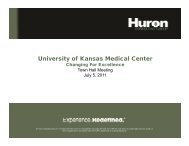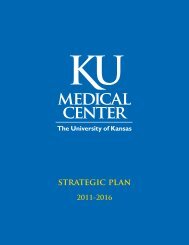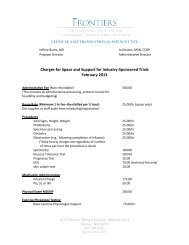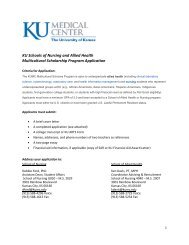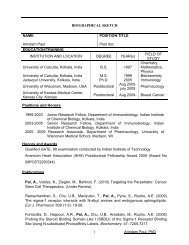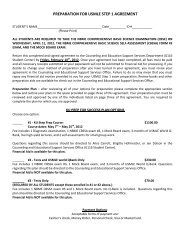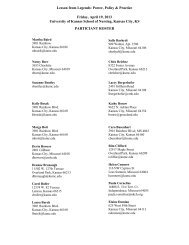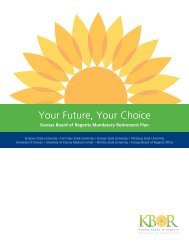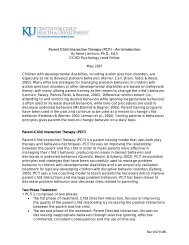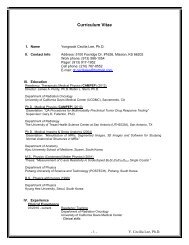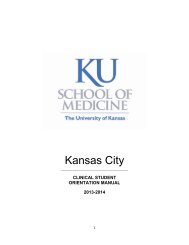Clinical Skills Assessment (CSA) - University of Kansas Medical ...
Clinical Skills Assessment (CSA) - University of Kansas Medical ...
Clinical Skills Assessment (CSA) - University of Kansas Medical ...
You also want an ePaper? Increase the reach of your titles
YUMPU automatically turns print PDFs into web optimized ePapers that Google loves.
<strong>Clinical</strong> <strong>Skills</strong> <strong>Assessment</strong> (<strong>CSA</strong>)<br />
The <strong>CSA</strong> is a clinical skills examination required for graduation from the School <strong>of</strong><br />
Medicine. The <strong>CSA</strong> uses standardized patient (SP) encounters to assess student<br />
performance in:<br />
<br />
<br />
<br />
<br />
Data gathering technique (history and physical examination)<br />
Interpersonal communication<br />
<strong>Clinical</strong> management (diagnostic strategy and treatment plan)<br />
Pr<strong>of</strong>essional documentation (post encounter note or PEN)<br />
<strong>CSA</strong> is a formal examination <strong>of</strong> the School <strong>of</strong> Medicine covered by the <strong>University</strong><br />
Honor System. Students must not discuss case content outside <strong>of</strong> approved sessions.<br />
Scheduling<br />
The <strong>CSA</strong> is provided on both the <strong>Kansas</strong> City and Wichita campuses on specified dates<br />
between May and July each year. Students should schedule <strong>CSA</strong> early to secure the most<br />
suitable date and location. Scheduling is arranged through<br />
Wichita students – Karen Drake, Office Academic Student Affairs 3-2603<br />
<strong>Kansas</strong> City students - Julie Mack, Neis <strong>Clinical</strong> <strong>Skills</strong> lab 8-2259<br />
Rescheduling can only be arranged in an emergency and only a limited number <strong>of</strong><br />
emergency slots are available.<br />
Format<br />
Each student completes 12 clinical encounters. In each encounter, the SP portrays a<br />
common clinical outpatient presentation. The specific location <strong>of</strong> the encounter (e.g.<br />
ambulatory clinic, emergency room) and other essential background information are<br />
provided for each case. The instructions for the case specify what is expected <strong>of</strong> students<br />
and the time allowed for the encounter. Typical instructions prior to a session are:<br />
Mary Brown has come to the ambulatory clinic today because <strong>of</strong> shoulder pain. You have<br />
15 minutes to take an appropriate history, perform a focused physical examination,<br />
communicate your assessment to the patient, and discuss an appropriate diagnostic and<br />
management plan with the patient.<br />
The instructions for the case also include vital signs and any essential information such as<br />
laboratory or imaging test results.<br />
Students should conduct the case as if they were the physician responsible for the patient.<br />
They must gather data from history and physical examination, communicate conclusions<br />
to the patient, and negotiate a management plan. All necessary equipment is provided to<br />
assess the case. If a sensitive physical examination (e.g. cornea, breast, rectal, vaginal) is<br />
indicated as part <strong>of</strong> the logical data-gathering for the case, students should tell the patient
they wish to conduct the examination. Appropriate information may then be provided by<br />
the patient.<br />
Each session is strictly timed. Students may not start reading case instructions or enter a<br />
room until given permission. A warning is broadcast into the room 5 minutes before the<br />
end <strong>of</strong> the session. Students must exit the room when instructed at the end <strong>of</strong> the session.<br />
After each encounter, the student has 10 minutes to complete a post encounter note<br />
(PEN).<br />
Scoring<br />
Each SP scores student performance using a checklist <strong>of</strong> key items for each case. These<br />
include essential aspects <strong>of</strong> history, physical examination, diagnostic and management<br />
plans AND aspects <strong>of</strong> communication skills. Each SP is trained to score about 25 specific<br />
key components for each case. In the example above, the scoring could include if the<br />
student asked about trauma or previous shoulder problems as well as any <strong>of</strong> the key<br />
questions for pain (location, severity, radiation, exacerbating factors etc), if range <strong>of</strong><br />
motion was tested, and if the student discussed the need for X-rays, pain relief or physical<br />
therapy. In all cases, the SP also scores on aspects <strong>of</strong> communication skills such as<br />
introduction, use <strong>of</strong> jargon, attention to patient comfort, and use <strong>of</strong> both open and closedended<br />
questioning.<br />
Faculty members score a sample <strong>of</strong> PENs for each student. The PEN scoring is based on<br />
documentation <strong>of</strong> key components for the case plus points for the organization, logic,<br />
legibility, and pr<strong>of</strong>essionalism <strong>of</strong> the note.<br />
Outcomes<br />
A team <strong>of</strong> 3 faculty members reviews the performances <strong>of</strong> any student identified by a low<br />
score or other concern. The outcomes <strong>of</strong> this review are provided to the Associate Dean<br />
for Student Affairs (<strong>Kansas</strong> City students) or the Associate Dean for Academic and<br />
Student Affairs (Wichita students).<br />
Feedback to students may take the form <strong>of</strong>:<br />
written feedback – with advice on specific issues <strong>of</strong> concern<br />
individual coaching – video review session(s) and advising by a faculty member<br />
clinical remediation – allocation to a clinical service and advisor to address specific<br />
serious problems in clinical skills.<br />
The choice <strong>of</strong> strategy depends on the most effective way to meet the learning needs <strong>of</strong><br />
the individual student.<br />
Logistics<br />
<br />
The <strong>CSA</strong> takes all day and requires a complex schedule to rotate all students through<br />
the appropriate mix <strong>of</strong> cases. Lunch and other breaks are provided. Students MUST<br />
stay on schedule. Arriving late at the beginning or after a break may result in not
eing allowed to complete the examination. If an emergency occurs, contact 3-3519<br />
(Wichita students) or 8-3430 (<strong>Kansas</strong> City)<br />
Pr<strong>of</strong>essional conduct and dress (white coat) are required<br />
Students must only bring stethoscope and writing materials. No pagers, cell phones,<br />
PDAs, reference materials or other resources are permitted. Everything necessary for<br />
the case is provided in the room.<br />
Faculty and staff monitoring <strong>CSA</strong> sessions have several roles, mainly to ensure SPs<br />
consistently portray the same scenario for every student and that the portrayal is<br />
clinically appropriate. No feedback can be provided to students in the course <strong>of</strong> the<br />
<strong>CSA</strong>.<br />
Confidentiality<br />
Discussion about the cases used in <strong>CSA</strong> is not only poor pr<strong>of</strong>essional behavior and a<br />
violation <strong>of</strong> the Honor Code, it is also extremely foolish. Information from other students<br />
about cases could be inaccurate or out <strong>of</strong> date as all cases are re-edited regularly and new<br />
cases introduced every year.<br />
More seriously, <strong>CSA</strong> tests the student’s ability to gather and interpret data, work through<br />
clinical problems, and communicate with patients, NOT the ability to reach a specific<br />
diagnosis. Cases may not have a single clear-cut diagnosis or may be specifically<br />
designed to asses how students handle a specific type <strong>of</strong> patient. Information about the<br />
diagnosis ahead <strong>of</strong> time is a serious handicap and results in lower scores as students miss<br />
points for exploring the full differential and potential alternative diagnostic and<br />
management strategies.<br />
Any suspected breach <strong>of</strong> confidentiality should be reported to the Associate Dean for<br />
Academic and Student Affairs (Wichita) or Associate Dean for Student Affairs (<strong>Kansas</strong><br />
City)<br />
Tips for <strong>CSA</strong> Success:<br />
Preparation<br />
1. Review your basic medical knowledge. Revise the clinical presentation,<br />
diagnostic strategy, and management <strong>of</strong> common clinical problems, including<br />
preventive and behavioral issues. All <strong>CSA</strong> and USMLE Step 2 CS cases concern<br />
common outpatient problems.<br />
2. Polish your history-taking skills. Use information from classes, references and<br />
the textbooks for CSE 1 to ensure you have an appropriate and logical approach to<br />
common patient presentations. If you find them useful, use lists and mnemonics to<br />
make sure you remember basics during a consultation. Common examples are:<br />
1 Le T, Bhushan V, Shahin FA, Sheikh-Ali M, Martin LD. First Aid for the USMLE Step 2 CS McGraw-<br />
Hill New York 2004<br />
Reteguiz JA Mastering the USML Step 2 CS 3 rd ed. McGraw-Hill New York 2005
the 7 classical questions for pain<br />
Onset (how did it start? Don’t forget to ask about trauma if appropriate)<br />
Location (where is it and does it radiate anywhere?)<br />
Quality (sharp? Dull? Electrical? Burning? Etc- in patient’s words)<br />
Severity (descriptive plus a 1-10 scale)<br />
Alleviating factors (anything that makes it ease or go away - position,<br />
medication, heat/cold, activity, food time <strong>of</strong> day etc)<br />
Aggravating factors (what makes it worse?)<br />
Associated symptoms (what else does patient link to pain e.g. nausea,<br />
chills, visual problems etc)<br />
and the “ rule” <strong>of</strong> 4 for components <strong>of</strong> previous medical, social, or family history<br />
(see Guidelines for Notes – provide link)<br />
PMH: illness/hospital/surgery (+ reproductive in women): medications:<br />
allergies: preventive/prospective care items<br />
SH: tobacco/alcohol/illicit substances: occupation/education: living<br />
situation: health habits<br />
FH: parents: sibs: “anything runs in family”: specific conditions related<br />
to case/patient<br />
and mnemonics for ADLs and IADLs<br />
DEATH dressing, eating, ambulating, toileting, hygiene<br />
SHAFT shopping, housekeeping, accounting, food preparation, transportation<br />
Caution: remember to adapt the general framework to each patient<br />
situation – don’t just have the same script for every case!!<br />
3. Review your physical examination techniques. Most cases require a focused<br />
exam <strong>of</strong> the body systems most pertinent to the differential diagnosis. Review the<br />
expected content <strong>of</strong> each focused exam in the USMLE-CS textbooks but use your<br />
best judgement to plan what to include in individual cases, balancing time against<br />
value <strong>of</strong> data gathered.<br />
Note ”sensitive” exams like rectal or vaginal are not expected in SP situations but if<br />
you believe it provides data you would normally gather in a case, ask the patient’s<br />
permission to do one. The SP may provide you the results on a card.<br />
The <strong>CSA</strong> and USMLE-CS require good technical performance <strong>of</strong> physical<br />
examination. Review the classical techniques in Mosby’s textbook and ask for help<br />
before the exams if necessary.<br />
Don’t forget the absolute basics <strong>of</strong> physical examination<br />
Wash your hands<br />
Tell the patient what you would like to do and why<br />
Ask patients’ permission to examine them<br />
Ensure patient comfort (e.g. asks where it hurts first, avoid causing pain)<br />
Expose what you need, especially abdomen and chest, but
Ensure appropriate draping and patient modesty<br />
NEVER, EVER listen or palpate through clothes<br />
Look confident, especially when using equipment<br />
4. Polish your communication skills. Use textbooks and reviews <strong>of</strong> your SP<br />
encounters during clerkships to ensure you cover the basics well:<br />
Opening: warm/pr<strong>of</strong>essional, eye contact, introductions (use patient’s formal<br />
name until given permission to use first names)<br />
Engage: open-ended questions to negotiate the agenda followed by a logical<br />
sequence <strong>of</strong> clarifying questions, avoid interrupting the patient<br />
Empathy: supportive, interested in the patient (use both words and your body<br />
language)<br />
Educate patient: assess and verify patient understanding <strong>of</strong> the situation, avoid<br />
using medical terminology/jargon<br />
Enlist: ask the patient’s views on the diagnosis, proposed work-up and<br />
management plan. Negotiate, don’t dictate!<br />
Close: summarize the most probable diagnosis and proposed diagnostic and<br />
management plan, arrange follow-up, and express support.<br />
Remember the SP will be scoring you on interpersonal communication as well as<br />
technical clinical skills.<br />
5. Review Documentation (PEN) Techniques. Use the Guidelines for<br />
SOAPs/PENs and feedback on the notes you prepared during formative SP<br />
sessions to be ready to do a complete, concise, pr<strong>of</strong>essional note in the 10 minutes<br />
allowed. You will be asked to type a subjective/history section, document your<br />
physical exam (don’t forget vitals!!), list up to five differential diagnoses in order<br />
<strong>of</strong> most likely, and then list up to five diagnostic tests. If you feel a diagnostic<br />
test is not needed, simply type, “No diagnostic test needed.”<br />
6. Practice makes perfect. Practice by seeing lots <strong>of</strong> patients on your clinical<br />
rotations and ask for feedback on your performance. Keep assessing and improving<br />
your skills.<br />
Tips for <strong>CSA</strong> Success: On the Day<br />
<br />
<br />
<br />
<br />
<br />
<br />
<br />
<br />
Arrive on time (or early) and well prepared<br />
Make sure you are rested and fed (no hypoing during sessions)<br />
Look and act pr<strong>of</strong>essionally<br />
Follow staff and faculty instructions<br />
Don’t get lost or turn up late<br />
READ the INSTRUCTIONS for EACH CASE, inc TIME ALLOWED<br />
Ditto, ditto, ditto<br />
Plan your initial strategy BEFORE going into the room (most likely issues? Best<br />
way to approach it? Things to definitely rule in/out? Key data needed? Priorities<br />
for decision-making? Potential problems?)
Positive entry – knock, introduction, use patient’s formal name, keep focus on<br />
patient<br />
Let patient present the problem, keep eyes and body looking interested (avoid<br />
taking excessive notes)<br />
Focused, logical clarifying questions sufficient to get the story but not “machine<br />
gunning” or exhausting patient. Be selective<br />
Watch for patient’s verbal and non-verbal cues<br />
Control your own mannerisms (e.g. wriggling, clicking pens, saying “ugh”!)<br />
Remember pertinent FH, SH, PMH, RoS (focused on problem)<br />
Perform only FOCUSED physical exam (if indicated in instructions)<br />
Wash hands prior to physical exam<br />
Attend to patient comfort and modesty<br />
Expose what you need, NEVER listen or palpate through clothes<br />
If there is a piece <strong>of</strong> equipment in the room, it probably has a purpose!<br />
Ask patient permissions and give explanations in physical exam or sensitive<br />
questioning<br />
Let the patient talk, especially when negotiating diagnosis and treatment plan<br />
Use the time well: if you finish early, something probably got missed!<br />
Don’t use jargon or words/phrases that the patient might not understand<br />
Conduct the interview as the physician <strong>of</strong> the day: you are not reporting to an<br />
attending physician/preceptor<br />
Follow the instructions for notes (PENs)<br />
Keep the adrenaline going – if one encounter does not go well, let it go! You have<br />
plenty <strong>of</strong> opportunities to shine with 12 cases.<br />
Treat each case like a real patient encounter<br />
<strong>CSA</strong>: Final Thought<br />
The <strong>CSA</strong> is a tough day but it is your opportunity to validate that you meet many <strong>of</strong> the<br />
clinical skills competencies <strong>of</strong> the School <strong>of</strong> Medicine and are ready for the next stage <strong>of</strong><br />
your education. In addition to your clinical skills, the <strong>CSA</strong> provides valuable data on the<br />
educational programs <strong>of</strong> the School and is used in curricular planning. Finally, the design<br />
is based on USMLE Step2-CS so should help familiarize you with that format.



